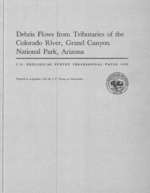A reconnaissance of 36 tributaries of the Colorado River indicates that debris flows are a major process by which sediment is transported to the Colorado River in Grand Canyon National Park. Debris flows are slurries of sediment and water that have a water content of less than about 40 percent by volume. Debris flows occur frequently in arid and semiarid regions. Slope failures commonly trigger debris flows, which can originate from any rock formation in the Grand Canyon. The largest and most frequent flows originate from the Permian Hermit Shale, the underlying Esplanade Sandstone of the Supai Group, and other formations of the Permian and Pennsylvanian Supai Group. Debris flows also occur in the Cambrian Muav Limestone and underlying Bright Angel Shale and the Quaternary basalts in the western Grand Canyon.
Debris-flow frequency and magnitude were studied in detail in the Lava-Chuar Creek drainage at Colorado River mile 65.5; in the Monument Creek drainage at mile 93.5; and in the Crystal Creek drainage at mile 98.2. Debris flows have reached the Colorado River on an average of once every 20 to 30 years in the Lava-Chuar Creek drainage since about 1916. Two debris flows have reached the Colorado River in the last 25 years in Monument Creek. The Crystal Creek drainage has had an average of one debris flow reaching the Colorado River every 50 years, although the debris flow of 1966 has been the only flow that reached the Colorado River since 1900. Debris flows may actually reach the Colorado River more frequently in these drainages because evidence for all debris flows may not have been preserved in the channel-margin stratigraphy.
Discharges were estimated for the peak flow of three debris flows that reached the Colorado River. The debris flow of 1966 in the Lava-Chuar Creek drainage had an estimated discharge of 4,000 cubic feet per second. The debris flow of 1984 in the Monument Creek drainage had a discharge estimated between 3,600 and 4,200 cubic feet per second. The debris flow of 1966 in the Crystal Creek drainage had a discharge estimated between 9,200 and 14,000 cubic feet per second. Determination of the effective cross-sectional area was a problem in all calculations involving superelevations on bends because areas near superelevation marks were 1.5 to 3.5 times larger than areas of upstream or downstream cross sections.
Debris flows in the Grand Canyon generally are composed of 10 to 40 percent sand by weight and may represent a significant source of beach-building sand along the Colorado River. The particle-size distributions are very poorly sorted and the largest transported boulders were in the Crystal Creek drainage. The large boulders transported into the Colorado River by debris flows create or change hydraulic controls (rapids); these controls appear to be governed by the magnitude and frequency of tributary-flow events and the history of discharges on the Colorado River. Reworking of debris fans by the Colorado River creates debris bars that constrain the size of eddy systems and forms secondary rapids and riffles below tributary mouths.


